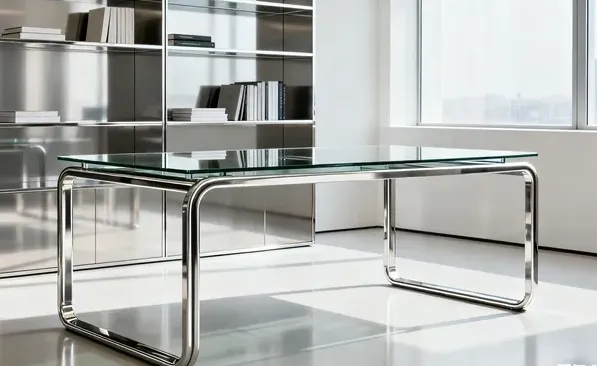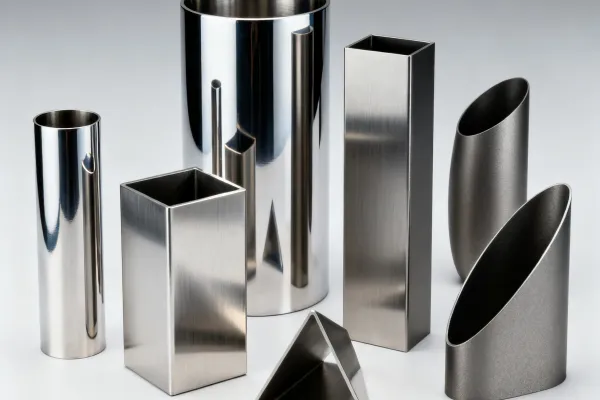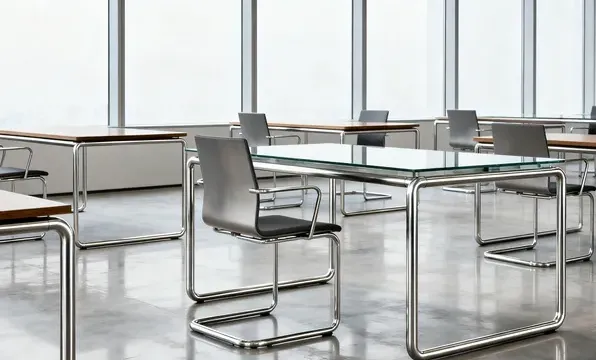Budgets suffer when frames rust, wobble, or arrive off tamanho. Delays grow; clients complain. Choose the right aço inoxidável tubo, finish, and tolerance to keep builds simple and reliable.
Tubo de aço inoxidável para mobiliário is precision tubo de aço used for frames, legs, rails, and bases. For most indoor projects, 304 with a satin polimento works. In tougher sites, select a marine grade and confirm one espessura da parede meets loads and the diâmetro exterior efetivo matches fittings.
Como profissional aço inoxidável manufacturer and exporter in China, we help fabricators, contractors, and distribuidor partners specify and buy dependable aço components without guesswork. Below is a straightforward guide you can use on the shop floor.
A tubo de aço inoxidável for frames is straight or bent aço made to tight especificação for chairs, tables, and shelves. It arrives cut, capped, and ready to join by fasteners or soldadura. The clean surface is easy to wipe and suits modern rooms. Compared with painted aço ou luz liga, a tubo inoxidável resists dents and staining, and it looks premium in public spaces. This metal blend keeps its sheen with simple care and arrives in a shop-friendly form. Designers like the smooth hand-feel and the tidy joints. For heavier frame-level needs, choose thicker sections and test mock-ups.

Para que servem os tubos de aço inoxidável
Most buyers pick Aço inoxidável 304 para interior spaces because it balances cost and performance. Where cleaning chemicals or splash are common—kitchens, pool decks, mild marinha areas—304 inoxidável can work with care, but 316 (higher níquel) adds insurance in ambientes de água salgada. On drawings, state the grau, finish, and tolerances. If a project notes “Aço inoxidável 304 e 316,” confirm availability before release. We stock key produtos de aço inoxidável and matching fittings to keep your inventário moving.
Cleaning reality. Splash zones see coffee, salt, ketchup, and sanitizer. Wipe downs with neutral cleaners keep the finish bright. Avoid steel wool or carbon brushes that can leave residue. If a surface pickles, passivation can restore brightness.
Material note. The alloy contains nickel and chromium. For seaside decks, shade and rinse help as much as material choice. Keep fasteners compatible so joints don’t show bimetal marks.
Tubing is described by tamanho, od e id. For press-fit parts, be sure the nominal dimensão in your catalog equals the diâmetro exterior efetivo on the bundle labels. Choose one espessura that meets loads and simplifies cutting.
Quick reference table
| Section | Diâmetro externo (mm) | Parede (mm) | Utilização típica |
| Round | 25.4 | 1.5 | Chair rails |
| Round | 38.1 | 2.0 | Table frames |
| Quadrado | 25.4 | 1.5 | Light frames |
| Retangular | 40×20 | 1.2 | Shelves |
Fit-up check. Use calipers and go/no-go gauges at goods-in. Measure roundness and flatness where parts will be visible. Label bins by section and cut length so the team grabs the right bundle every time.
Tolerances that matter. Frame appearance depends on straightness, twist, and end-cut squareness. Specify carton drop tests and corner protection during transit. Thin films or sleeves prevent rub lines on satin finishes.
Round profiles feel friendly to touch and bend smoothly. A quadrado tubo (also called square steel section) stacks well and resists twist. Rectangular sections add stiffness in one axis, great for benches that need slim looks but solid support. For ornamental projects in the office or lobby, pair a satin polimento with hidden fasteners. For rugged installs, choose brush finishes that hide scuffs. A single square tube size across a program can cut waste.
Ergonomics. Handrails and chair backs feel best with soft transitions. Where a square look is required, soften the outside corner and keep the inside radius neat so hands don’t catch.
Joinery choices. Designers often hide joints under seats or table tops. Where joints are visible, aim for symmetric gaps and aligned grain so reflections look even under downlights.

different shapes of stainless steel tube
For most frames, welded aço is the value choice. Modern lines make a clean seam that vanishes after finishing. Choose seamless only where tight ovality or deep machining justifies the cost. Both routes are valid produtos de tubagem. Tell your fornecedor a aplicação and target grau so they can propose a route from plant to shop. If you need perfect edges, specify deburring and end caps. Good packaging protects corners during distribution.
Lead time. Rolled products with a longitudinal join are quicker to replenish and easier to source in varied finishes. True hollows without a seam are suited to very tight machining or where you want minimal ovality.
Cost levers. Bundle size, coil choice, cut lengths, and finishing passes set most of the cost. Grouping SKUs reduces setup time and protects budgets on large runs.
A #4 satin polimento is the universal choice for tables and handrails; it balances glare control with easy cleaning. Mirror finishes look premium but show fingerprints. Acabamento de fresagem is fine for hidden parts and later coating. Smooth corners and sealed joints keep crumbs and moisture out. Clear caps save time on site. Consistent finishing also makes assemblies look aligned even under bright light.
Care and cleaning. Daily wipe-downs with mild soap and microfiber keep marks away. Fingerprints show more on mirrors; brushed hides handling well. Where grit is common, add floor glides and end caps to protect legs.
Visual quality. Align grain direction on multi-part assemblies. Where two rails meet, ensure the finish lines up across the joint so the look stays consistent in strong light.
Use jigs for repeat cuts and holes. Proper fit-up limits distortion during soldadura. For thin sections, pulse settings help. If you cut with laser, test speed to avoid edge color. Plan fixtures so parts self-locate and stay square while cooling.
Cutting and prep. Use sharp saws or fiber cutting wheels for clean edges. Deburr immediately and seal ends that won’t be seen. For coping joints, templates reduce setup time.
Fasteners. In public seating, thread-locking compounds and flange nuts stand up to vibration. Use nylon washers near visible faces to protect the finish during assembly.
Bending. Control mandrel position and lube to protect the finish. Cold bending keeps the line crisp on thin walls; heat is possible on heavier aço but watch the final look.
Many projects reference ASTM A554 for architectural tubing or ASTM A312 for tubo in process areas. Add finish, grau, diâmetro exterior, espessura da parede, and cut length on the print. A simple QA plan that cites iso 9001 keeps audits clear. Tolerances matter. Call out hole dimensão, slot width, edge distance, and carton stacking tests. Protective film preserves the finish through shipping and install.
Packaging tests. Write simple checks into the PO: drop-test cartons from 0.8 m, strap spacing every 250 mm, and corner guards on all faces. Clear labels with lot codes and cut length reduce mix-ups on site.
A tubo de aço is sized by od; a tubo by internal flow capacity. For frames and seats, the aço tubo keeps weight down and joints tidy. Use tubo mainly where threads or fluid handling drive the design. For heavier construção or display racks, check section modulus and deflection. Rectangular sections help where you need depth; round profiles offer friendly touch points.
When to choose flow hardware. If the design carries fluid or uses threaded connectors, piping standards may be right. For frames and displays, tubing stays lighter and more compact at the connections.
Indoors, 304 works in public spaces and clean rooms. Outdoors or near chlorides, choose 316 to handle heat and corrosion exposure. In harsh ambiente, add drain holes and specify routine cleaning.
Materials. If weight is critical, some teams compare light alloy to aço molduras. Aço wins on dent resistance and can be refinished. Always verify the mechanical properties your load case needs.
Maintenance plan. Post signs in staff areas showing the right cleaners and sponges to use. Schedule quick wipe-downs at closing and a deeper clean weekly. Rinse after de-icing salts in winter.
Drainage and caps. Drill discreet vent holes where water might collect, then cap ends to keep moisture out. Tiny details add years to service life in outdoor cafés and transit hubs.
Work with a factory that proves química composition and keeps material traceable. Ask for grau certificates, lot numbers, and test reports. A capable partner offers OEM/ODM personalizado cuts, drilling, and kitting so parts arrive ready to build. As a China-based plant, we export produtos siderúrgicos globally and support long-term programs for retailers and builders. We also supply matching fittings so your aço program looks unified and duradouro in daily use.
Quality routine. Keep heat numbers on every bundle and scan them into receiving. Archive plant certs with the PO so field teams can trace parts later. Photograph the first completed set before mass production.
Service model. Long programs benefit from standing orders. Agree on buffer stock, carton counts per pallet, and color-coded labels so replenishment stays predictable across regional warehouses.
A furniture maker standardized a 38.1 mm redondo tubo de aço with one espessura. The line saw faster assembly and fewer returns. By locking a single tamanho and finish, they cut scrap and simplified jigs. After one year, the frames still looked new. The buyer kept the same partner because the parts delivered load capacity without redesign.
They also met needs in aplicações estruturais and kept strength and corrosion resistance across daily use.
Numbers that matter. The brand cut setup time by 22% and scrap by 14% in the first quarter after standardizing. Warranty claims fell close to zero. With better kitting, two assemblers built a table set in 11 minutes versus 18 before.

stainless steel tube in office tables and seating
Small choices change total landed cost more than you think. Longer stock lengths mean fewer joins and less scrap. Unified cut lists reduce saw time. If you can standardize hole patterns and radii across models, jigs pay for themselves. Even packaging adds up: nested parts, shared cartons, and consistent pallet footprints reduce freight by double digits.
Finishing passes. Each pass consumes time and abrasives. If a clean brushed look works for the brand, avoid mirror levels unless the photo set truly needs it. Ask your shop to record actual pass counts on the first article so both sides see the real process time.
Kitting keeps throughput high. Label parts by station order, not by SKU alone. When an assembler receives the kit in build sequence, their hands move less and quality rises. Pictures on bin cards help new staff match parts at a glance.
“Quality is built during design; production only makes it visible.” — shop foreman, seating line
Design with repair in mind. If a leg gets scuffed, a swap-out part is cheaper than replacing an entire frame. Avoid permanent adhesives where a bolt can do the job. At end of life, frames can be dismantled and recycled. Clear component labels help local recyclers sort materials quickly.
You can also reduce impact upstream. Fewer unique profiles across a program mean fewer changeovers, less waste, and a smaller footprint. Ask suppliers for energy-saving ideas — sometimes a simple change in belt type or abrasive saves power without changing the look.
Good scheduling protects campaigns and openings. Share forecasts early so coils and cartons line up. If you run a seasonal product, consider a buffer in a neutral finish, then tune final color later. Keep a two-tier reorder rule: when stock drops below the first level, start the next run; below the second, ship from the buffer.
For global programs, map the journey from plant to regional DCs to stores. Shorter hops reduce risk. Where seasons differ, offset builds so one region’s slow period balances another’s peak.
Is stainless steel tubing different from pipe?
Sim. Tubagem de aço inoxidável is dimensioned by od and id, enquanto tubo is based on flow. Frames usually favor tubing for compact joints.
Do you carry both welded and seamless options?
Sim. Soldados e sem costura covers most needs at best value. Seamless is for specialty jobs. Both routes can meet tight tolerances when specified.
Which finish is easiest to maintain indoors?
A satin polimento. It hides minor scratches yet cleans quickly, ideal for public areas and kitchens.
Can you assist with kitting and cuts?
Yes. We provide OEM/ODM personalizado cut-to-length parts, drilling, coping, and labeling to speed assembly.
What grades are stocked?
We produce Aço inoxidável 304 e 316 in round, quadrado, and rectangular, plus matching fittings. Certificates list química elements and heat numbers.
Principais conclusões
References: ASTM A554, ASTM A312, SSINA: Corrosion, Outokumpu data sheets.
Fabricantes de tubos de aço inoxidável: Explicação sobre tubos sem costura, de liga e de aço inoxidável
Tubos de aço inoxidável soldado: Aço inoxidável 304, 321, diâmetro externo/espessura da parede e especificações de tubos
Design do corrimão de aço inoxidável: Idéias de corrimão e corrimão de aço inoxidável para sua escada
Qual é o melhor tubo de aço inoxidável para mobiliário? Guia de tubos de aço e tubagem de aço (Mobiliário metálico) - Como escolher o fornecedor certo